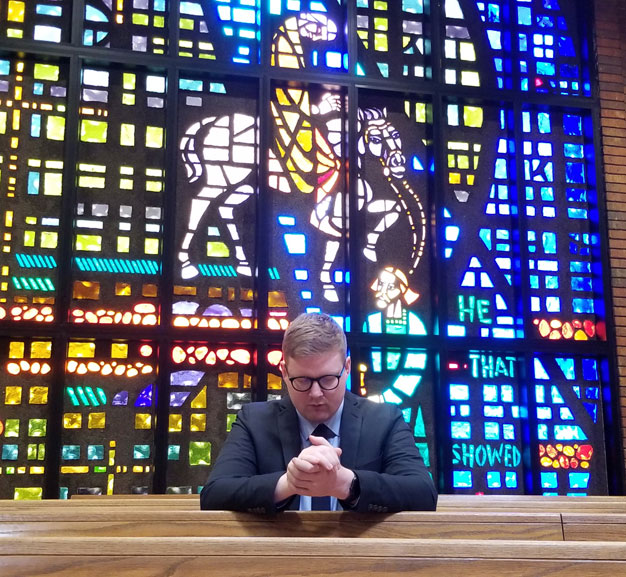
Seminarian Cameron Costello prays at Our Lady of Victory Parish in Davenport earlier this month.
By Lindsay Steele
The Catholic Messenger
St. Joseph never speaks in the Bible and perhaps because of it he has become for many a symbol of contemplative prayer and an openness to God’s love and direction.
“St. Joseph is attentive to God even while he is sleeping, and when he receives the messages from the angel, he immediately wakes up and obeys,” said Dan Teets, leader of the Iowa City Fathers of St. Joseph. “St. Joseph sacrificed by taking Mary into his home, fleeing with Mary and Jesus to Egypt, and returning only when God sent him the message that it was the right time.” Catholics can follow St. Joseph’s example by “listening to God in our hearts, in our rest and in our dreams as St. Joseph did.”
About contemplative prayer
Throughout history, Catholics have engaged in contemplative prayer. For Your Marriage, an initiative of the U.S. Conference of Catholic Bishops (USCCB), notes that contemplative prayer “is much less about saying things to God and is more about what God is saying to us.” Essentially, contemplative prayer is an act of sitting quietly with God and being open to his presence.
“The Catechism of the Catholic Church,” in its section on contemplative prayer, quotes St. Teresa of Avila who wrote, “Contemplative prayer in my opinion, is nothing else than a close sharing between friends; it means taking time frequently to be alone with him whom we know loves us.” In its 13 paragraphs on contemplative prayer, the Catechism describes aspects of this form of prayer, calling it a gift, a gaze of faith fixed on Jesus, hearing God’s word, and an experience of silence (CCC 2709–2724).
Finding peace in silence
Cameron Costello, a seminarian for the Diocese of Davenport, regularly prays in the presence of the Blessed Sacrament, a practice he began several years ago while discerning a call to the priesthood. Generally, he starts with spontaneous prayer, prayers of thanksgiving and Scripture readings. He then sits in silent reflection with his eyes closed for several minutes.
“It’s not always rainbows and butterflies” when you’re sitting with God, he said. “There’s turmoil and chaos in everyone’s hearts, especially because we’re sinners.” Yet, Costello finds comfort and reassurance during that time of quiet contemplation. “God loves us more than we can imagine, but we forget that.” He often leaves eucharistic adoration with a peaceful feeling that lingers throughout the day.
He believes that taking time to be still and feel God’s presence can be difficult for young adults like himself, especially with the busyness of life and ubiquitous technology access. “What I’ve heard from other young people is that it’s worth it” to take time to step away and be present with God each day. “It changes people’s lives when they make that choice.”
A loving gaze
Many religious orders, including the Discalced Carmelites, follow a call to contemplation. Barbara Grothe, a member of St. John Vianney Parish in Bettendorf, has been a part of the Secular Order of Discalced Carmelites for nearly 25 years, making a lifelong commitment to the order in 2019. Secular Carmelites spend about two hours a day in prayer, 30 minutes of which are devoted to contemplative prayer. “A life of prayer builds a solid life on what we know we can count on God.”
She usually starts out praying the Liturgy of the Hours and then sets a timer for 30 minutes. “Next I close my eyes and talk to God about whatever. Sometimes I complain a lot. Sometimes I share my concerns. Mostly, I pour out my heart to God because he cares for me. Then, I am still and try to surrender everything to him. It’s quiet,” she said.
Contemplative prayer “is the most transformative prayer for me personally,” Grothe said. “As more than one saint has said of this type of prayer, ‘I look at God and God looks at me.’ It is a loving gaze.”
‘Abide in me’
Lectio divina is another way to practice contemplative prayer. With Christian roots in the Benedictine tradition, it starts with a slow, deliberate reading of Scripture or sacred text followed by meditation, silent prayer and contemplation.
Hal Green, formerly of Muscatine, has taught and written about prayer extensively. Lectio Divina is among his daily prayer practices. “We can encounter God through Lectio Divina,” he said. “My daily prayer practice is built upon John 15:4, 9, where Jesus says, “Abide in me as I abide in you…. Abide in my love.”
During contemplative prayer, Green imagines Jesus sitting across from him and gently, lovingly, repeating these words. “It becomes a breath prayer, where I breathe in ‘Abide in me,’ and breathe out ‘As I abide in you.’ In between breaths, I hear Jesus saying,
‘Abide in my love.’ After several minutes, I am ready to face the day, loved by and abiding in Christ, who also is abiding in me.”











